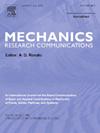三倍孔隙率纳米材料热弹性耦合线性理论
IF 1.9
4区 工程技术
Q3 MECHANICS
引用次数: 1
摘要
本文提出了考虑达西定律耦合现象和宏、中、微三级孔隙体积分数概念的三孔热弹性纳米材料的线性数学模型。然后,建立了该模型稳态振动的三维内外基本边值问题。在考虑的理论中,建立了辐射条件,得到了格林恒等式。最后,证明了上述问题经典解的唯一性定理。本文章由计算机程序翻译,如有差异,请以英文原文为准。
On the coupled linear theory of thermoelasticity for nanomaterials which triple porosity
In this paper, the linear mathematical model of thermoelastic nanomaterials with triple porosity is proposed in which the coupled phenomenon of Darcy’s law and the concept of the volume fractions of three levels of pores (macro-, meso- and micropores) is considered. Then, the 3D internal and external basic boundary value problems (BVPs) of steady vibrations of this model are formulated. The radiation conditions are established and Green’s identities are obtained in the considered theory. Finally, the uniqueness theorems for classical solutions of the above mentioned BVPs are proved.
求助全文
通过发布文献求助,成功后即可免费获取论文全文。
去求助
来源期刊
CiteScore
4.10
自引率
4.20%
发文量
114
审稿时长
9 months
期刊介绍:
Mechanics Research Communications publishes, as rapidly as possible, peer-reviewed manuscripts of high standards but restricted length. It aims to provide:
• a fast means of communication
• an exchange of ideas among workers in mechanics
• an effective method of bringing new results quickly to the public
• an informal vehicle for the discussion
• of ideas that may still be in the formative stages
The field of Mechanics will be understood to encompass the behavior of continua, fluids, solids, particles and their mixtures. Submissions must contain a strong, novel contribution to the field of mechanics, and ideally should be focused on current issues in the field involving theoretical, experimental and/or applied research, preferably within the broad expertise encompassed by the Board of Associate Editors. Deviations from these areas should be discussed in advance with the Editor-in-Chief.

 求助内容:
求助内容: 应助结果提醒方式:
应助结果提醒方式:


